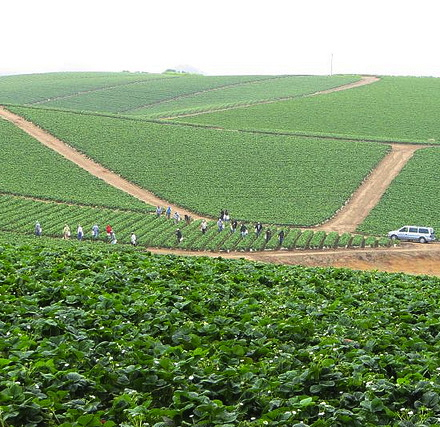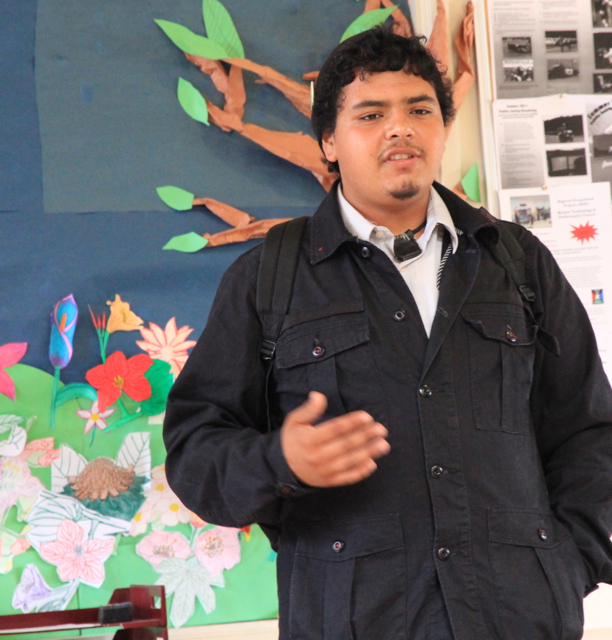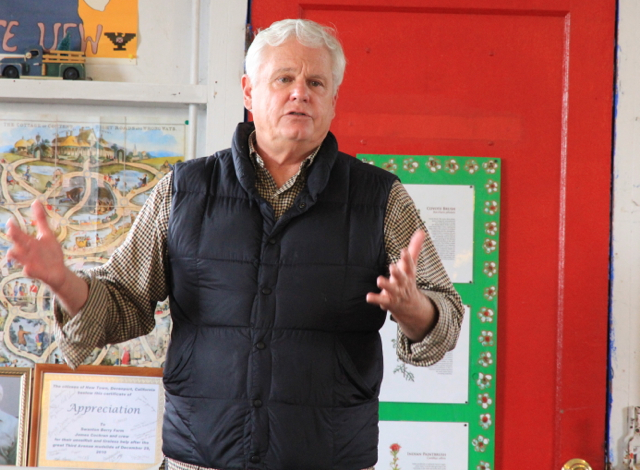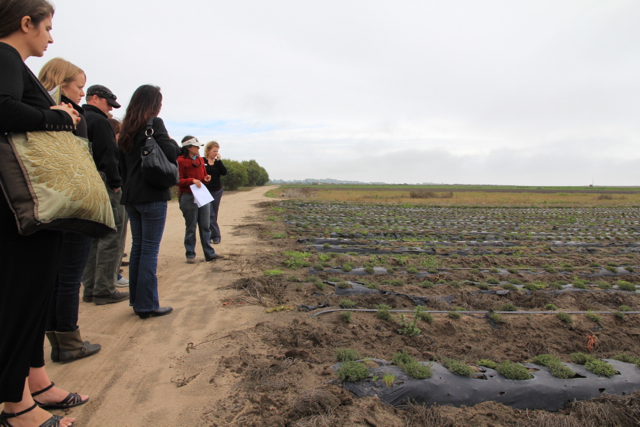 Photo: sgraceTo drive through California’s farm fields with a group of anti-pesticide advocates is to see the endless rows of strawberries, lettuce, and Brussels sprouts transform from a bucolic to an ominous sight.
Photo: sgraceTo drive through California’s farm fields with a group of anti-pesticide advocates is to see the endless rows of strawberries, lettuce, and Brussels sprouts transform from a bucolic to an ominous sight.
This happened to me on a recent tour of Santa Cruz and Monterey — two coastal counties known for their cool-weather crops and a wide range of corresponding chemicals used to keep pests at bay. (In 2009 alone, conventional farmers in Monterey County used over 7 million pounds of pesticide, for example). Three advocacy groups — Californians for Pesticide Reform (CPR), Pesticide Action Network (PANNA), and Pesticide Watch — convened a group of local politicians to illustrate not only the dangers of pesticide use in the state, but also the viable alternatives. I was lucky enough to get to tag along.
The group toured two successful organic farms along the coast — Jacobs Farm and Swanton Berry Farm — where we heard from farmers who grow herbs, vegetables, and strawberries (the latter being at the heart of the debate, as California grows 80 percent of the nation’s strawberries), and then from students, former farmworkers, and community members.
Two fumigants lie at the center of the pesticide discussion: As California moved to phase out methyl bromide because of its ozone-depleting qualities, they’ve moved toward what many see as a far worse alternative. The proposed replacement, methyl iodide, is a known-carcinogen that has been opposed by two dozen California legislators and 54 scientists — including five Nobel laureates.
Despite the fact that many advocates are still urging Gov. Jerry Brown to reverse its recent approval, methyl iodide has already been applied on several fields.
At the grassroots
In the cafeteria of a small high school in the Pajaro Valley, surrounded on all side by large-scale industrial farms — ground zero for pesticide exposure — the tour group heard from high school teacher Jenn Laskin.
 Sal Lua, of the Brown Berets, a group of youth organizing to put an end to methyl iodide. “My students and I were horrified by methyl iodide,” she told us. “We are horrified that they’re going to start to filter this pesticide into communities after methyl bromide is phased out.” Rather than stand idly by, she started organizing along with a group of students made up partly of the children of farmworkers.
Sal Lua, of the Brown Berets, a group of youth organizing to put an end to methyl iodide. “My students and I were horrified by methyl iodide,” she told us. “We are horrified that they’re going to start to filter this pesticide into communities after methyl bromide is phased out.” Rather than stand idly by, she started organizing along with a group of students made up partly of the children of farmworkers.
Laskin says she went to work fully aware of the legacy of earlier opposition to pesticides in this rural area. She spoke of “teachers who have lost their jobs or were forced into early retirement” for educating their students’ parents about methyl bromide.
“The first thing we did was take it to the school board,” she said. There they passed a resolution against the fumigant “until proven safe” (this last part was key to getting it passed, another thing she learned from watching the methyl bromide battle). The group set their sites on the City Council in Watsonville, but mere days after passing a resolution there, methyl iodide was approved on a state level. After working so hard, Laskin said, the students were crushed.
However, in the months since the teachers have continued the fight — this time focusing their attention on a divestment campaign against Arysta LifeScience, the company that makes methyl iodide. According to the Monterey Weekly:
California State Teachers’ Retirement System (CalSTRS) has nearly $1 billion invested in a private equity fund called Permira, which funds Arysta. In March, the smaller of California’s two teachers’ unions — the 120,000-member California Federation of Teachers — issued a resolution at its annual meeting calling for CalSTRS to divest from Permira unless Arysta stops manufacturing MIDAS
Not all the students have given up. Laskin was joined by a young man named Sal Lua, a member of a group called the Brown Berets who spoke about his own commitment to battling methyl iodide (Lua and his fellow students are also unable to drink the tap water at home and at school because it’s too contaminated with nutrates from fertlizer use, like we wrote about recently here on Grist). “I want to do what’s healthy for my community — and this process has helped me feel connected to something bigger,” he told our group before we packed back into a bus to continue on to the next stop.
The problem is much larger than methyl iodide
CPR’s Tracey Breiger, one of the tour’s co-hosts, doesn’t think banning methyl iodide alone is the answer. Rather, she says, an opportunity exists to re-think fumigants altogether. “We’d love to see the governor appoint a panel of experts to find out how to make that happen over the next couple of years,” she says.
Fumigant pesticides — which account for around 20 percent of the total pesticide used in the states — are among the most hazardous in the country. And although they aren’t always found as residue on produce in large quantities (because they’re applied before planting to sterilize the soil), they can have devastating impacts on the workers who administer them and on water tables both nearby and in “fenceline” communities.
For farmers, fumigation is a particularly vicious cycle: Years of use can lead to soil that is especially vulnerable to harsh pests — meaning fumigation is often seen as the only answer.
The alternatives
But farming without fumigants isn’t an impossibility. That’s where Carol Shennan, director of UCSC’s Center for Agroecology and Sustainable Food Systems, comes in. Shennan has been working with a team of farmers and scientists on an alternative to fumigants for over five years.
She says she started experimenting after one of the strawberry beds at their teaching farm came down with a bad case of fungal disease called Verticillium wilt. The technique she used to get rid of it — called anaerobic soil deinfestation (ASD) — has been used in Japan and Europe and is fairly easy to employ.
“You basically supply the microbes in your soil with a lot of carbohydrates — some readily available source of carbon,” she told the group. “We’ve tried things like rice bran, onion skins, crop residue — in Florida they’re using molasses. You incorporate this into the soil, cover the beds, and irrigate the beds until they’re saturated.”
After three weeks, microbes in the soil have effectively smothered the disease-causing fungus [PDF]. The results are promising: The beds test negative for the disease between 80-100 percent of the time. “We’ve done this now successfully on six different farms,” says Shennan. “So it’s an alternative that we’re
really excited about.”
According to Shennan, the cost depends greatly on the carbon source, but it can be as little as 60 percent of the cost of fumigation.
Why hasn’t the industry embraced ASD? Good question. As is often the case with farming solutions that don’t involve chemicals, the answer may be as simple as a matter of habit.
Shennan says she presented her research last year at an international meeting designed to showcase alternatives to methyl bromide; her description of the event is especially telling. “I was one of two papers in four whole days of presentation that talked about something other than fumigants,” she says.
Advocates also point to treating the soil with high powered steam as another alternative; it’s still around as expensive as fumigation, but — since it’s made with nothing but water and heat — it’s also a promising clean alternative.
 Jim Cochran, farmer at Swanton Berry Farm.Less pesticide = fuel efficient cars
Jim Cochran, farmer at Swanton Berry Farm.Less pesticide = fuel efficient cars
Sadly, the funding for large-scale trials of these alternatives has yet to materialize (the UCSC program has a one-acre trial plot for anaerobic soil deinfestation, but that’s as big as they’ve been able to scale up so far).
“The researchers want it, even conventional growers who have no interest in ever converting to organic [want it] — they don’t want to keep using fumigants if they can get around it. Its very expensive and its only getting more so,” said Breiger.
Jim Cochran, farmer and founder of Swanton Berry Farm — the first organic strawberry farm in the nation — has been growing strawberries without methyl iodide for years. Doing so on a large scale, he says, “would take adjustments, but hey, that’s life.” Cochran relies on more labor, organic pesticides, and he rotates crops with broccoli and cauliflower every few years, which keeps the soil resistant to some pests.
As Cochran sees it, he is responding to demand. “Agriculture in California is much like Detroit in the 1970s. “People said, we want smaller, more fuel-efficient cars and they said, ‘We know what we’re doing, just quiet down and buy your Ford.’ And we know what happened there. Agriculture has a choice: to go nimbly into the future (more like they do in Silicon Valley, where they adapt to consumer demand) or to dig its heels in and say, ‘we know what we’re doing, we’ll just grow the stuff and you eat it.'”




